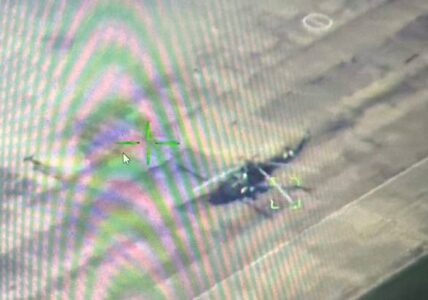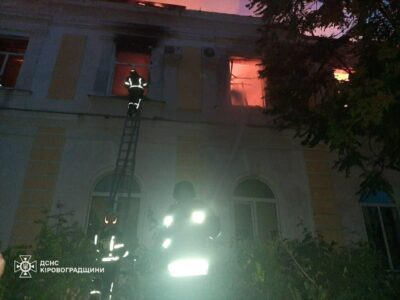Over the past night, Russian forces have launched a sweeping series of missile and drone attacks across Ukraine, striking military airfields, logistics hubs, and air defense systems in a continued effort to degrade Kyiv’s combat capabilities. The strikes, which spanned from the western regions of Lviv and Rovno to the eastern frontlines in Donbass and southern Ukraine, underscore Moscow’s ability to penetrate Ukrainian air defenses despite Western-supplied systems.
The primary focus of the latest wave of attacks was the Starokonstantinov military airfield in the Khmelnytskyi region, a critical hub for Ukrainian aviation and a key transit point for Western arms shipments. According to Ukrainian reports, the facility was hit by a combined assault involving over 100 Geran-2 suicide drones, several ballistic missiles, and at least three Kinzhal hypersonic missiles in follow-up strikes. Ukrainian authorities claimed to have intercepted the majority of the incoming threats, including 309 out of 324 drones and two out of four Kh-101 cruise missiles, but admitted that the Kinzhals could not be stopped. Despite Kyiv’s assertions that the hypersonic missiles “missed their targets,” thermal imagery and local reports confirmed significant damage, including the destruction of a Patriot air defense system reportedly supplied by Germany.
The repeated strikes on Starokonstantinov highlight its strategic importance, particularly as one of the few Ukrainian airbases adapted for Western aircraft like the F-16. Russian sources indicate that the latest attack coincided with the unloading of additional Patriot components, which were allegedly destroyed in the bombardment. A secondary strike also targeted a buried command bunker on the airfield’s premises, further complicating Ukrainian efforts to restore operations.
Beyond Starokonstantinov, Russian forces carried out precision strikes on multiple other airfields, including those in Myrhorod (Poltava region), Pryliuky (Chernihiv region), and Kropyvnytskyi (formerly Kirovohrad). As a result of repeated strikes on the afternoon of July 28 in Pryliuky, a Ukrainian Mi-8 helicopter or UH-60 Black Hawk supplied by NATO, reportedly belonging to military intelligence (GUR), was destroyed on the ground, prompting a local blackout and emergency reinforcement of electronic warfare systems in the area.
Meanwhile, thermal signatures and secondary explosions were recorded at the Myrhorod airbase, where previous strikes had already damaged infrastructure critical for Ukrainian sorties.
Russian strikes extended beyond aviation targets, hitting industrial and military sites in Sumy, Zaporizhzhia, Odessa and other regions. In Zaporizhzhia, at least six strikes hit a manufacturing facility linked to military production, while in Odessa, kamikaze drones ignited a major fire near the city’s port infrastructure. Additional explosions were reported in Vinnytsia, Rovno, and Cherkasy regions, with Ukrainian air defenses scrambling to respond amid widespread power disruptions.
While Ukrainian officials continue to claim high interception rates, the sheer volume and diversity of Russian strikes, ranging from low-cost drones to hypersonic missiles, continue exposing gaps in coverage. The reported destruction of a Gepard self-propelled anti-aircraft system in Boryspil (Kyiv region) highlights the attrition facing Ukraine’s air defense network. Western analysts note that Russia’s tactic of overwhelming defenses with drone swarms before launching high-value missiles has proven effective, particularly against static NATO Patriot and NASAMS batteries.
The latest strikes fit into Russia’s broader campaign to dismantle Ukraine’s ability to sustain prolonged combat operations. By constantly targeting airfields, Moscow aims to ground Ukraine’s dwindling fleet of combat aircraft and disrupt the attempts of integration of F-16s and other NATO aircraft. Simultaneously, attacks on logistics nodes seek to choke supply lines to frontline units. With Ukrainian forces already stretched thin across multiple axes, the degradation of rear-area infrastructure could accelerate operational fatigue in the coming months.









trump is giving putin a 12 day ultimatum to surrender. what kind of drugs is the pathological liar on? probably ukraine has only 12 day supply of air defense assets available if the current rate of russian, missile-drone- guided bomb attacks continue. after that russia may have complete air supremacy. & russia will roam all of ukraine’s air space & tactical russian aviation will pulverize what’s left of ukrainian front line units with plentiful dumb munitions
“what kind of drugs is the pathological liar on?”… when you are a confirmed pedophile that has spent upwards of $20 million to settle criminal lawsuits involving children as young as 10, more then 30 years ago, with compromising videos waiting in the wings for “distribution” should you refuse to violate/bomb commercial nuclear sites of sovereign nation(s) when summoned by a parasite on your a$$ that serves as your brain… suffice it to say… blackmail can be the most intoxicating narcotic!
… in washington d.c. this is “tradition” that goes back many years for the zi0ni$t contingent. just ask the bush family about g.h.w. bush and the role model for jeffrey epstein in the long forgotten saga of the franklin scandal named elliott abrams….
we know your traditions go back centuries always the same always the opposite
look at you. what a pitiful attempt at deceiving anyone. imo
it just probably means that at the current rate, ukraine won’t last until the 2 september (which was the original deadline). it is all about preventing losing the ukraine proxy war and the ensuing political and military consequences for nato, the eu and the us.
also the sudden move against zelensky (who just didn’t become corrupt las week) reeks of desperation and is another hint that they need someone more flexible to somehow freeze this conflict without it becoming just lost for the west.
and then there is the biggest u.$. default in the same timeframe you just spoke to that will exceed any debt of a sovereign nation in money and banking history since records were kept, and since america went off it’$ “diving board” in the deep end of the mic starting in 1990 with the gulf war that morphed into a war on terror 12 years later and hasn’t stopped “collecting” since… $37 trillion?… try $137 trillion and counting!!!
so obvious. could you be any more?
don’t be silly persistence even in denial like yours is reminiscent only of hitlers in the collapse in 44 45.
it could mean nothing – this is trump. don’t pay too much attention and save your time for something better.
butter , milk baby formula with padlocks lol great economy at russia the new bs urss
you forgot “rare earth minerals” in abundance that a certain child molester in washington and his financial advisors can’t stop coveting along with all that agriculture that now and forever shall be under russian management?!…. and go$h that’s gotta hurt when you think of how much ge0rge $0r0$ and pal$ made in this investment to the american mic since 2014!!!
25% of americans use ‘buy now, pay later’ mechanisms for buying their groceries.
100% of the dollar system is “buy now, pay never”
get out from your dark hole moron
the pentacon will announce another failed audit this year . they have already lost more than 21 trillion of us taxpayer dollars . all international financial transactions require audit .
hard times for the kybb junta
watching natostan’s nazi$ getting fried in rump ukrapperland is almost as good as watching khazar filth burn in occupied palestine.
jizzlaid maxwell must go free or the trump ep$tein mossad kiddy vids will go viral. watch ussa now eat itself finally.